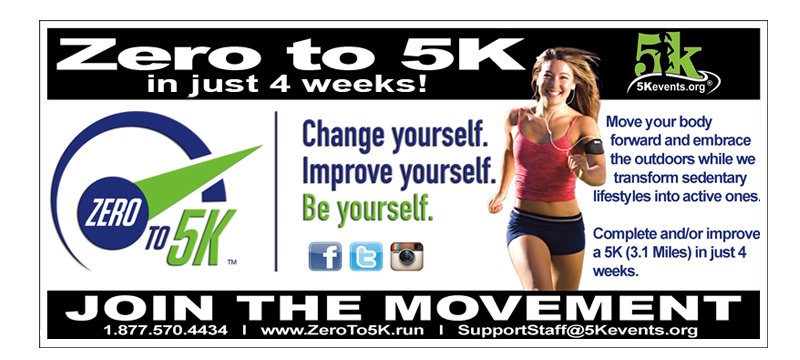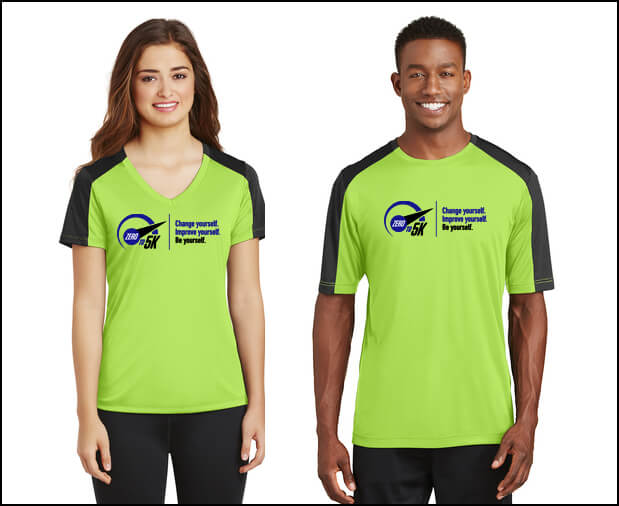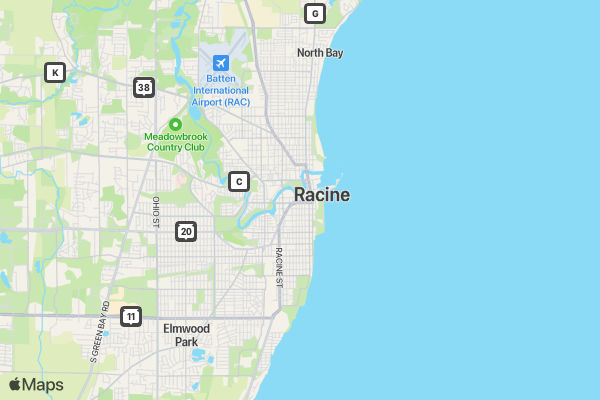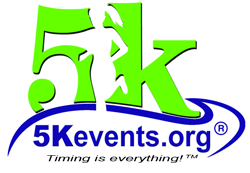Zero to 5K Fitness Program
Zero to 5K Fitness Program Race Description

VENUE: 5Kevents, 215 6th Street, Racine, WI 53403
TIME: 6 am to 7 am on Tuesday, Thursday and Saturdays
Running or Walking a 5K is a great way to stay or get fit, feel better and even form new relationships with other participants. Starting a new running habit doesn't have to be hard - all it takes is a comfortable pair of shoes and a willingness to move a little or a lot, all at your own pace. We make it easy to get started, get inspired and stay on track. Are you ready?
Let's go! The “Zero to 5k” is a 4 week running and fitness program designed to get just about anyone from the couch to running 5 kilometers in just 4 weeks. Just invest 30 to 60 minutes of your time for 4 weeks and enjoy the numerous health benefits that will follow! After 4 weeks, stay on board for our accelerated program designed for upper body strength while increasing your overall time during a 5K.
We'll provide an upbeat, committed and fun training environment for anyone ready to begin or enhance their running abilities and get fit in the process.
![]()
WE WANT TO SAVE YOU MONEY:
- Participate for free - Refer 5 people (50% Credit), 10 people and we'll credit 100% of your registration fee!
- Share and save - $2.00 during registration
TRAINING SCHEDULE:
- M,W,F: Self training based on schedule
- T,TH,S: Join us for a group run/walk as we train along Racine's Lakefront
The absolute best way to keep yourself running is to find a race, sign up for it, pay for it and put it on your calendar. A fixed race date will help you stay focused, and keep you on a regular running schedule. A beginner can run any race, you just need to allow enough time to train for it. Check out our races at http://5Kevents.raceentry.com


Zero to 5K | Run, Walk or Crawl Program:
Zero to 5K is a gentle introduction to getting the body moving, you’ll start off alternating between walking and running small distances, and slowly building up. After 4 weeks, you’re ready to run 5 kilometers or 30 minutes non stop.
First off, you may be asking, “exactly how many miles is a 5K?” A 5K is 3.1 miles.
Many newcomers to running become discouraged by the difficulty associated with the activity because they start too fast and push too hard. Their bodies rebel, and they wind up miserable, wondering why anyone would possibly want to run in the first place. The Zero to 5K program has been specifically designed to instill a love of running and will be encouraged to join in on local events. https://5kevents.raceentry.com/
We’re here to help you achieve your goal(s), be it your first 5K, improving your run, or simply offering a resource where you can run with a group that is designed to help each other stay motivated. You should ease into your 5K training plan gradually. In fact, the program we provide is less of a running regimen than a walking and jogging program. The idea is to transform you from a non-runner, getting you to begin running a 5K ( or 3.1 miles) and on a regular basis in just 4 weeks.
It’s easy to get impatient, and you may feel tempted to skip ahead in the program, but hold yourself back. Don’t try to do more, even if you feel you can. If, on the other hand, you find the program too strenuous, just stretch it out. Don’t feel pressured to continue faster than you’re able. Repeat weeks if needed and move ahead only when you feel you’re ready.

FAQ :
Q: What kind of shoes do I need?
A: Ignore shoe sales pitches about pronation or high arches and don’t be swayed by brand names. Instead, try on four or five running shoes, jog around the store and let your feet decide. In a review of the science on running shoes and injuries, researchers found that the most important feature of a running shoe is (brace yourself) — comfort. That’s it. Choose a shoe that feels good.
Q: Do I need special socks?
A:While most runners focus on shoes, socks can be important too. Blisters from bunched-up socks are painful and could sideline you for days. You want a breathable, snug sock that’s not suffocating. Some running socks are made from a sweat-wicking material that draws moisture away from your feet, preventing bacteria from accumulating between your toes which inevitably leads to foot odor.
Look for a sock without thick (or any) seams and decide if you want a no-show sock or one that covers the back of your ankle where shoes sometimes rub. Try socks on in the store, and pick one or two that you like. Test them out to see how they perform when you run and sweat before investing in multiple pairs.
Q: Can I listen to music while I run?
A: Our coaches would prefer you not, but we all do anyway. So go ahead and pick your playlist. Just keep one ear open to hear the coaches. Running should feel like a reward. If you’re a runner who likes the quiet and solitude of running, then pick a bucolic path and go run. But many people like a combination of upbeat music or short podcasts or books on tape to accompany them on the run. A personal favorite is to train with books by comedians, who often read their own audio books and leave us laughing so much we forget were training.
OUR PICKS
| Snap Judgment Host Glynn Washington takes listeners to his weekly podcast on a fascinating ride of personal stories told through sound. | |
|
Born to Run Christopher McDougall finds a tribe of the world’s greatest distance runners. He finds out that everything we thought we knew about running is wrong.
|
|
| Naked David Sedaris tells short, sharp and hilarious tales from the rich terrain of his life. |
Q: Do I need a timing Device?
A: Every runner needs a timing device to help manage his or her training. Whether you choose a standard watch, a high-tech GPS watch or your iPhone doesn’t really matter. Just pick the timing device that works for you.
Q: Do I need to be on a special diet during my training?
A: What you put in your body is just as important as what you wear when you start running. Consider food as part of your gear.
What to Eat
Make a fist. That’s about the size of what you need to eat before and after you run. So, think appetizer, not meal. It should also include carbs with some protein. The traditional peanut butter sandwich is a great option as a workout snack. Eat half of the sandwich one hour before your run and half soon after. Low-fat chocolate milk works very well, too.
When to Eat
One of the biggest mistakes that new runners make is to not eat at all before exercise, so you don’t have any fuel to keep you going. Plan to eat one hour before your run to boost energy without upsetting your stomach.
When you’ve finished running, eat within 15 minutes of stopping — it helps the body re-synthesize muscle glycogen and recover more quickly. It may also help prevent or reduce delayed-onset muscle soreness.
Your workout snack shouldn’t replace a meal. Keep your routine of breakfast, lunch and dinner and add in the pre- and post-exercise snack. That means eating at least five times a day. When people are physically active, anything under three meals a day is not going to be enough.
Q: How do I stay Hydrated?
A: Quench your thirst, but don’t overdo it.
Water
Hydration is a big concern for new runners, but it shouldn’t be. The best tip for staying hydrated during a run is: Drink when you are thirsty. You can carry a regular-size water bottle in one hand when you run or you can plan a route around a few bubblers.
Sports Drinks
Electrolytes are water-soluble nutrients, like sodium, that can leave the body through sweating. So-called sports drinks can replace these electrolytes in the body. However, the length of your workout should be the guide for what you drink. If you run for less than an hour, water is just fine. After running for an hour, your body begins to need those nutrients, so a few sips of a sports drink can help you maintain your energy levels. But as with all things, a little bit of a sports drink can go a long way. These drinks often contain sugar, which your body doesn’t need if you are otherwise eating a healthy diet. They can also get pretty pricey. So, while sports drinks serve a purpose among elite athletes and those who exercise for long periods, for those who exercise at a moderate intensity for an hour or less, water is probably the better choice.
Too Much Water
You can drink too much. So, don’t gulp down bottles of water before a run, thinking it will prevent you from getting thirsty. Drinking excessive amounts of fluid will not prevent you from cramping or prevent heat-related illnesses. Those ailments generally stem from simply pushing yourself too hard. Overhydration can be a more serious issue than dehydration anyway. So, drink when you need to, and don’t overdo it.
Q: Will I lose weight during this program?
A: Running is a great way to stay healthy, but it’s not always a successful weight loss method. Here are a few tips to help you trim down as you tone up.
Avoid Runner's Weight Gain
Running burns calories, which means your body will be hungry and you may begin eating more than usual. The result for many new runners, surprisingly, is weight gain rather than weight loss. To avoid that, try working out for 30 minutes instead of 60. The shorter workout will still get you in shape, burn some calories and help you get ready for race day — but it won’t leave you starving for more food.
Count Your Calorie Burn
One mile of running burns about 100 calories, but that doesn’t mean you’ll lose a pound for every 35 miles you log. Running more will make you hungrier and likely to eat more. The level of intensity or running up a hill will increase the amount of calories you burn. Your body will be tired so you may sleep a little more. All of this will affect weight loss. If you eat a balanced diet and try to maintain your calorie intake as you run, you may also lose weight as you become more fit.
Q: How do I prevent injury during my training?
A: The worst part of running is the pain that comes along with your new routine. Don’t let cramps, side stitches or pain keep you off the road.
Stretching
You don’t have to waste your time sitting on the curb touching your toes or pulling your legs backward to stretch your thigh muscles. While there has been recent evidence that static stretching — holding a stretch for a period of time — can prevent acute muscle injuries like tears or strains, such types of injuries are uncommon in runners. In fact, holding a stretch too long can even make your muscles less powerful.
Instead, you could try dynamic stretching, which warms your muscles through repeated movements. For runners, an ideal warm-up might include squats, lunges and “form drills” like kicking your buttocks with your heels. While some professional (and amateur) runners swear by these pre-run warm ups, there are no studies that show that dynamic stretching prevents injury.
The bottom line? If you don’t have time to stretch or warm up before you run, don’t worry about it. If you like the way stretching feels before a run, go for it. Just don’t hold your stretches. Keep your muscles in motion to prevent straining them before you hit the road.
Straight-Leg-March
If you like to stretch before you run, try this dynamic stretch for your hamstrings and gluteus muscles.
Side Stitches
Nothing can ruin a good run like a side stitch. Runners who regularly slouch their backs are more likely to experience those spasm-like cramps in their abdomen. When you feel a stitch coming on, take a deep breath to arch your back and try to run more upright.
While side stitches are generally felt above the hip, sometimes they can be felt all the way up to the shoulder. However, if the pain persists for more than a few minutes after you slow down, especially if it’s on the left side of your body, it could be a sign of a heart attack. So be cautious and see a doctor.
Relieving Side Stitches
The sudden onset of side stitches can ruin a good run. Here’s how you can prevent them.
Leg Cramps
Cramps during exercise could be a result of over-excited nerve endings, probably as a result of fatigue. Studies of triathletes and ultramarathon runners have found that those who cramp during a race tend to be racers who bolt from the start, setting an early pace that is much faster than their normal training speed, inviting fatigue. They also often have a history of the condition, suggesting that once a muscle cramps, it is primed to repeat the spasms.
Luckily, treatment is simple. “Stretch the affected muscle,” said Kevin Miller, an exercise scientist at Central Michigan University in Mount Pleasant. Stretching seems to quickly calm the manic, misfiring nervous system connections in the muscle.
Some athletes swear by a swallow or two of pickle juice, which is known to alleviate cramps.
Feet
The most common running injuries involve the feet. The repetitive banging of your heels and toes on the pavement can cause some real aches and pains. Many runners take pride in the blisters, calluses and bruises — not to mention the loss of a toenail or two — that inevitably occur after logging mile after mile of their runs. Unfortunately, besides getting comfortable shoes and some top-notch socks, there isn’t much one can do to avoid those types of injuries.
The good news is that the pain of one of the most common foot injuries — plantar fasciitis — can be alleviated with a simple stretching routine.

-


-
Zero to 5K Fitness Program Where & When
- Location: Anywhere USA, Racine, WI 53405
-
Categories:
- May Training 5.1 - 5.28.22
- June Training 6.5 - 7.2.22
- July Training 7.10 - 8.6.22
- August Training 8.14 - 9.10.22

 Gmail
Gmail Yahoo
Yahoo Outlook
Outlook Email
Email





